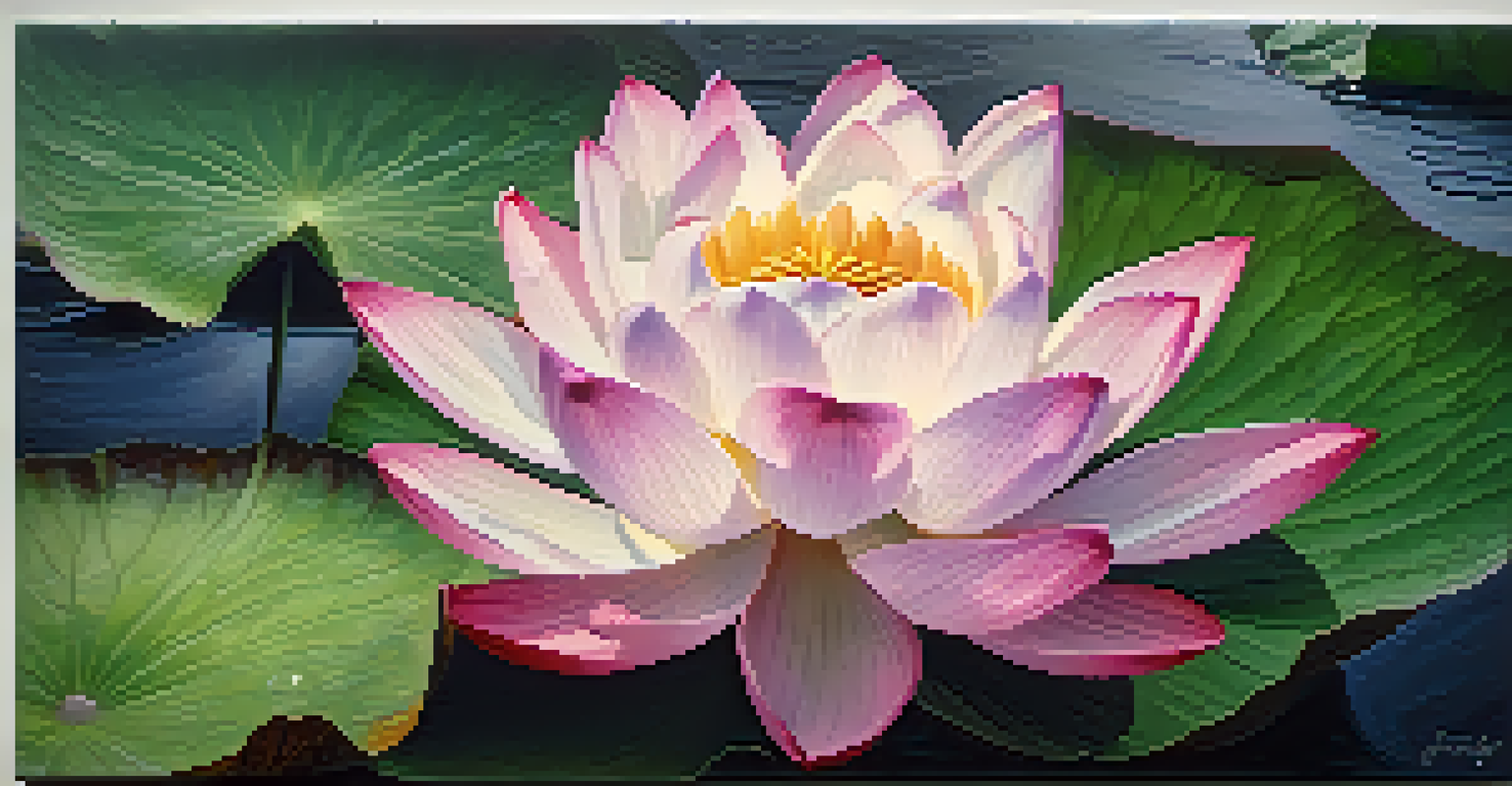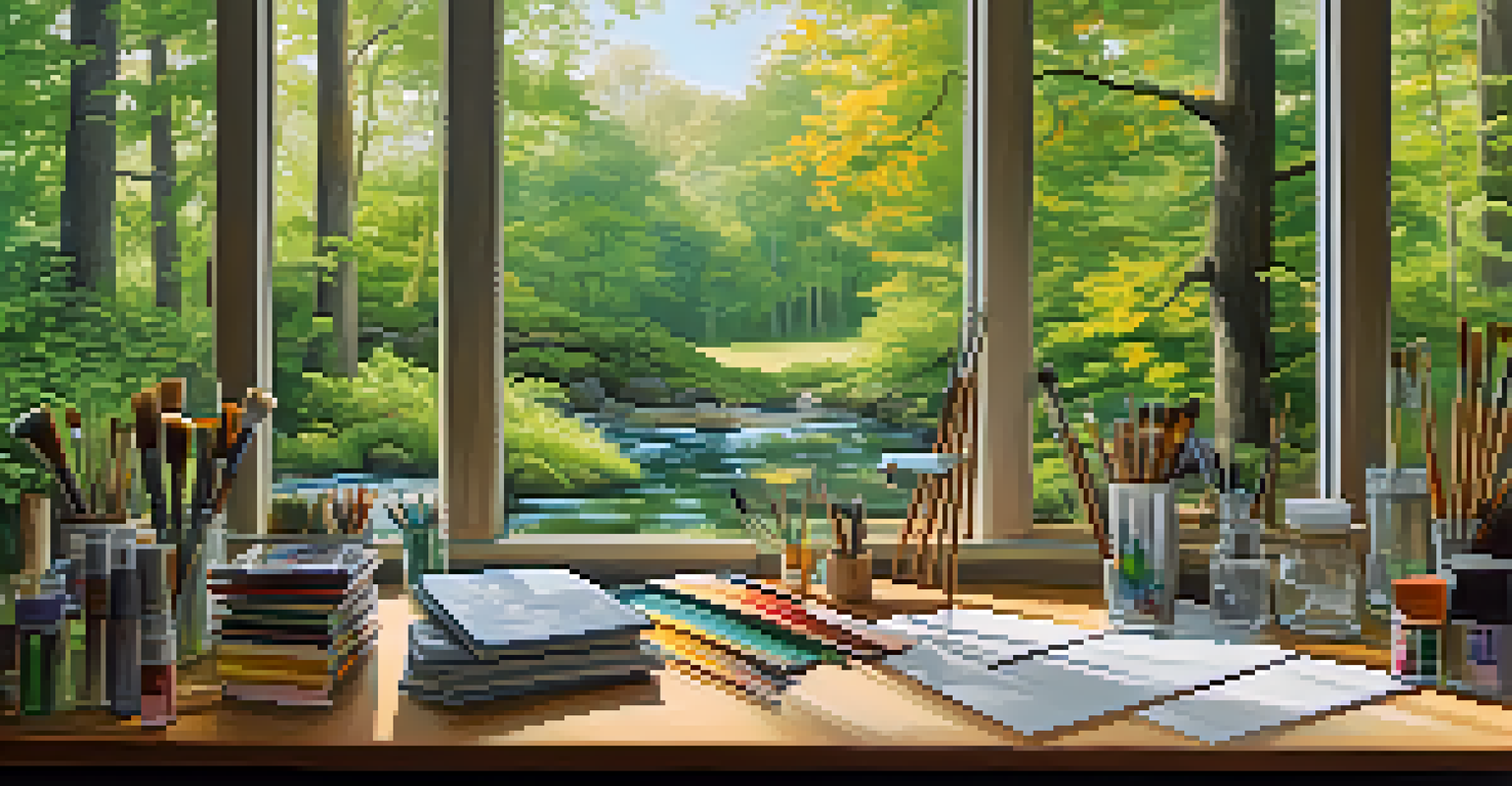The Connection Between Nature and Spirituality in Art

Nature as a Source of Inspiration in Art
Nature has long been a muse for artists, providing an endless canvas of inspiration. From the vibrant colors of a sunset to the intricate details of a leaf, the natural world invites creativity and evokes emotions. Artists like Claude Monet captured the beauty of gardens and landscapes, showing how nature's splendor can translate into visual storytelling.
Nature is not a place to visit. It is home.
This connection between nature and art isn't just about aesthetics; it’s also about the feelings and thoughts nature stirs within us. For many artists, being immersed in nature sparks a deeper understanding of life and existence, which often translates into their work. This can be seen in the way landscapes are portrayed, reflecting not only the physical beauty but also a sense of peace and tranquility.
Moreover, nature's transient beauty reminds us of the cycles of life, a theme often explored in art. The changing seasons, the life cycle of plants, and even the weather can influence an artist’s mood and work, leading to pieces that resonate on a spiritual level with viewers.
Spiritual Themes in Nature-Inspired Art
Art that draws from nature often delves into spiritual themes, exploring concepts such as harmony, balance, and interconnectedness. For instance, many Indigenous cultures incorporate natural elements into their art to express their relationship with the earth, seeing themselves as part of a larger ecosystem. This perspective fosters a sense of respect and reverence for nature, which can be spiritually uplifting.

In addition, artworks that depict nature can evoke feelings of awe and wonder, leading to moments of introspection. The vastness of a mountain range or the serenity of a forest can prompt viewers to reflect on their own existence and place in the universe. This sense of connection can be incredibly powerful, illustrating how nature serves as a bridge to spiritual experiences.
Nature Inspires Artistic Expression
Artists draw from nature's beauty and complexity to create works that resonate emotionally and spiritually.
Artists like Georgia O'Keeffe have effectively conveyed these spiritual connections through their work, using floral motifs and landscapes to explore themes of femininity, strength, and the sacred. By capturing the essence of nature, they invite viewers to engage with the spiritual dimensions of their art.
The Role of Meditation and Mindfulness in Artistic Creation
Many artists find that spending time in nature enhances their creative process through meditation and mindfulness. The practice of being present in nature allows for a deeper connection to the surroundings, fostering inspiration and clarity. This kind of mindful observation can lead to a more profound understanding of the colors, shapes, and textures that inform their artwork.
Art is the most beautiful of all lies; it is a bridge to the truth of our interconnectedness with nature.
Moreover, incorporating meditation into the creative routine helps artists to quiet their minds and tap into their inner thoughts and emotions. This can be particularly beneficial when they are trying to convey spiritual themes in their work. By grounding themselves in the present moment, artists can channel their experiences and feelings into their art more authentically.
Many contemporary artists emphasize the importance of this practice, often sharing how moments spent in nature have influenced their artistic journey. This emphasis on mindfulness not only enriches their work but also connects them to a wider community of creatives who value the spiritual aspects of artistic expression.
Symbolism of Nature in Spiritual Art
Nature is rich with symbolism that artists often utilize to convey deeper meanings. Trees can symbolize life and growth, while water might represent purification or transformation. By incorporating these symbols into their artwork, artists create layers of meaning that resonate with viewers on a spiritual level.
Consider the use of the lotus flower in various cultures; it symbolizes purity and spiritual awakening. Artists who depict this flower are tapping into a longstanding tradition that connects their work to a broader spiritual narrative. This use of symbolism illustrates how nature serves not just as a backdrop for art, but as a fundamental element of spiritual communication.
Spiritual Themes in Nature Art
Nature-inspired art often explores themes of interconnectedness and harmony, reflecting deeper spiritual connections.
Furthermore, the interpretation of natural symbols can vary across cultures, enriching the conversation around spirituality in art. By exploring these symbols, artists can engage with diverse audiences, prompting reflection and discussion about the interconnectedness of nature and spirituality.
The Impact of Nature on Artistic Techniques
The physical environment plays a crucial role in shaping an artist's techniques and styles. For instance, the colors of a particular landscape can influence the palette an artist chooses, while the textures found in nature may inspire specific brushwork or materials. This connection can lead to unique expressions that reflect both the artist's vision and the essence of the natural world.
Moreover, artists often experiment with natural materials, such as earth pigments or organic fibers, to create a more authentic connection to their subject matter. This practice can enhance the spiritual quality of their work, as the materials themselves carry the essence of nature. By using these elements, artists not only honor their source of inspiration but also create pieces that resonate with viewers on a deeper level.
The evolution of techniques inspired by nature can also be seen in movements like Impressionism and Abstract Expressionism, where artists sought to capture the essence of their experiences in nature rather than just a realistic representation. This shift reflects a growing awareness of the spiritual dimensions of art and the importance of the artist's personal connection to their environment.
Nature's Influence on Art Movements and Styles
Throughout history, various art movements have been profoundly influenced by nature, shaping both styles and philosophies. The Romantic movement, for example, emphasized the beauty and emotional power of nature, often portraying it as a source of inspiration and a reflection of the human spirit. This movement encouraged artists to explore their feelings and spirituality through their depictions of the natural world.
Similarly, the Arts and Crafts Movement celebrated traditional craftsmanship and the beauty of natural materials, emphasizing a return to nature in artistic expression. This focus not only created beautiful works of art but also fostered a deeper appreciation for the spiritual connections found in the natural world. It underscored the idea that art should reflect the values of simplicity and harmony inherent in nature.
Art as Environmental Advocacy
Contemporary artists use their work to promote environmental awareness, highlighting the spiritual importance of nature conservation.
In contemporary art, we see a resurgence of interest in nature as artists seek to address environmental issues and the spiritual implications of our relationship with the earth. This ongoing dialogue between art and nature continues to evolve, demonstrating that the connection between spirituality and the natural world is not just a fleeting trend but a timeless theme in artistic expression.
Art as a Medium for Environmental Spirituality
In today's world, art serves as a powerful medium for expressing environmental spirituality. Many contemporary artists focus on themes of nature conservation and ecological awareness, using their work to inspire a deeper connection to the earth. Through powerful imagery and poignant messages, they encourage viewers to reflect on their relationship with the environment and the spiritual ramifications of neglecting it.
This movement has given rise to eco-art, where artists use sustainable practices and materials to create works that celebrate and protect the natural world. By doing so, they not only highlight the beauty of nature but also evoke a sense of responsibility towards its preservation. This artistic engagement can lead to a transformative experience, prompting individuals to consider their role in the ecosystem.

Moreover, art that addresses environmental issues often encourages community involvement, fostering a collective spiritual awakening. As people come together to appreciate and protect nature through art, they form deeper connections with both the environment and each other, reinforcing the idea that spirituality and nature are inextricably linked.